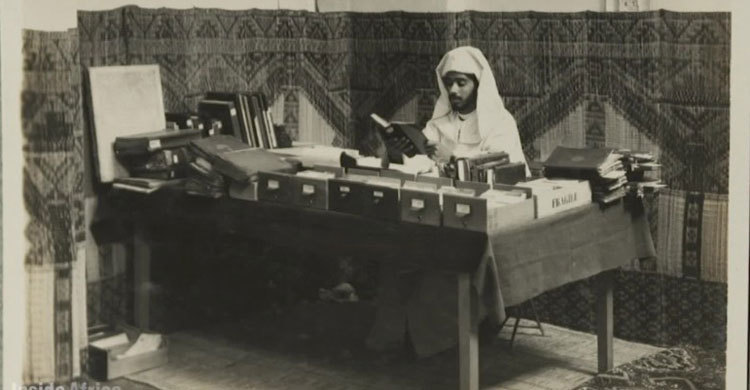Oldest university meets 21st century with massive restoration

“A wise man without a book is like a workman with no tools.” So goes an old Moroccan proverb. For centuries, wise men have flocked to the city of Fez seeking knowledge from the books held within its ancient library at al-Qarawiyyin. Scholars and students at the adjacent university, as well local artisans, have long drawn from its carefully curated manuscripts, providing a touchstone to Morocco’s past as pioneer in Islamic arts and science.
Nestled within the city’s medina, the institution is only 30 years younger than Fez itself. The oldest university in the world, according to Guiness World Records, al-Qarawiyyin opened in 859 AD under the patronage of Fatima al-Fihri, a wealthy Arab woman who also commissioned a mosque and madrasa. Its library came along in 1359 AD and contains manuscripts that are among the earliest in Islamic history. A ninth century Quran, a 10th century account of the Prophet Muhammad’s life, as well as formative scientific and medical textbooks can all be found here.
From generation to generation, custodians have kept these precious documents under lock and key for generations, working to the thrum of copper artisans hammering away outside the library’s walls. While wars have raged and colonizers come and gone, al-Qarawiyyin has stayed much the same.
Yet being a living historical artifact has brought its own problems.
Over centuries, rain water trickled off the neighboring mosque’s roof, seeping into the library. Unbeknownst to the staff, the situation had gotten so bad a stream of water was slowly flowing beneath al-Qarawiyyin’s floorboards. Rot set in and the building’s foundations were in danger.
“Fez has been a pivotal center of learning, especially for Islamic studies,” says Moha Ennaji, professor of linguistics and culture and the University of Fez. But with its centerpiece falling into disrepair, the city’s status was under threat.
The Ministry of Culture kicked into action, enlisting Aziza Chaouni and her team of architects to oversee a major renovation of the library. Engineers re-built foundations, installing a new sewage system; each tile of the building’s iconic green roof was restored individually and painstakingly relayed.
Perhaps unsurprisingly, the ancient site had concealed some secrets over the years.
“We were always discovering things as we were ripping out walls,” says Chaouni. Among them was a doorway connecting the library and the mosque, hidden within a 16th century cupola.
The rebuild has also brought in a few modern touches -- lighting, heating and air conditioning, and in the basement, a high-tech laboratory built for restoring precious manuscripts.
“The library authorities have decided lately to actually scan them and digitize them, so that they can be kept on disc for future use,” says Ennaji. “[The] manuscripts are very old and they may be lost or destroyed just by use, so we have to be very cautious.”
Al-Qarawiyyin’s cautious approach is reaping rewards. But after five years there’s still no fixed date for the formal public opening, when everyone from Fez and beyond will finally be able to read the library’s old tomes.
“The sooner we can open the library the better, as every day there are researchers who find out that the library is still closed,” says Abdelfattah Bougchouf, curator at al-Qarawiyyin. “The quicker we can finish it the happier it will make us.”
If Fez’s population is being forced to wait a while before its curiosity is sated, then it can always take a stroll around its medina, a UNESCO World Heritage Site and the oldest in the world.
Its warren of alleyways, like al-Qarawiyyin, is also being revitalized, under the watch of Fouad Serrhini, director of ADER Fes, the body in charge of the historic medina.
“We have about 83,000 people living in the medina, about 30,000 people working in handicraft,” says Serrihini, who himself was born and raised within its walls. “Even today, you can see that there is this homogeny, this marriage between tradition and modernity,” Ennaji notes, citing the satellite dishes that dot rooftops for as far as the eye can see.
“For more than 150 years [the medina has been in] a cycle of degradation,” Serrihini explains. But ADER Fes is updating the UNESCO site’s infrastructure, including uncovering the medina’s narrow rivers -- which Serrihin says some residents weren’t even aware of.
In doing so the renovations have supplied thousands of artisans with fresh water for their workshops, while the scheme has installed solar capture to heat personal water supplies too.
“If business is not good with the artisans, business is not good in the whole city,” says one of the medina’s fez hat makers. From metalworkers to clothworkers, the aim is “to translate [the medina’s] cultural value into economic value,” says Serrihini.
When al- Qarawiyyin finally opens its doors, these artisans, as well as scholars and students, will finally be able to return to the library’s hallowed reading rooms. And with the crown jewel of Fez restored, the city’s status will be assured for many centuries to come.
Source: CNN


